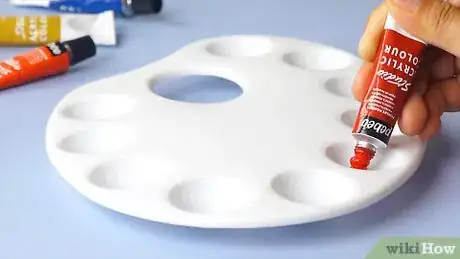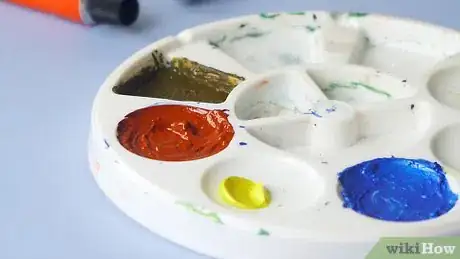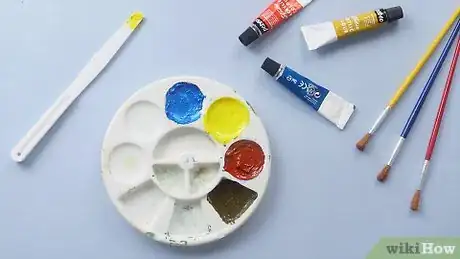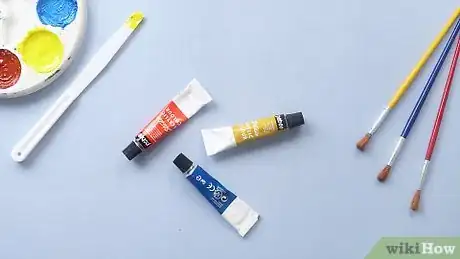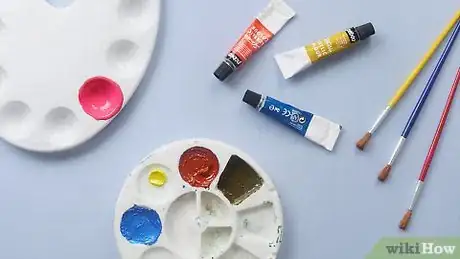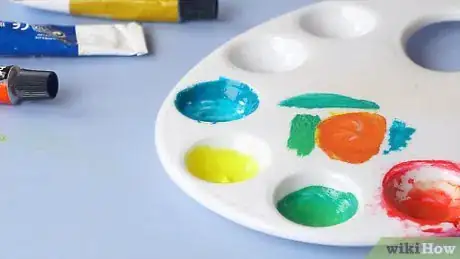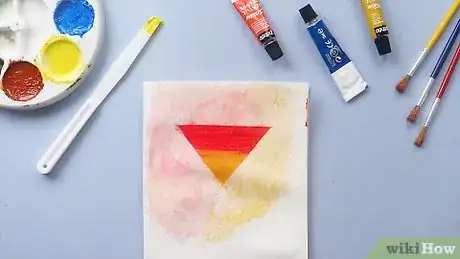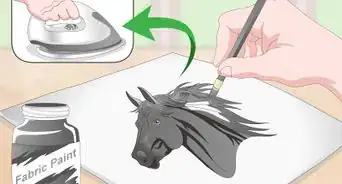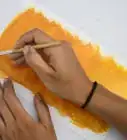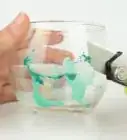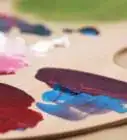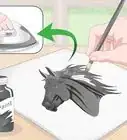This article was co-authored by Kelly Medford. Kelly Medford is an American painter based in Rome, Italy. She studied classical painting, drawing and printmaking both in the U.S. and in Italy. She works primarily en plein air on the streets of Rome, and also travels for private international collectors on commission. She founded Sketching Rome Tours in 2012 where she teaches sketchbook journaling to visitors of Rome. Kelly is a graduate of the Florence Academy of Art.
There are 9 references cited in this article, which can be found at the bottom of the page.
wikiHow marks an article as reader-approved once it receives enough positive feedback. In this case, several readers have written to tell us that this article was helpful to them, earning it our reader-approved status.
This article has been viewed 478,426 times.
Acrylic paint is a medium commonly used by artists. You can thin acrylic paint to achieve differences in consistency and color, allowing you to attain effects that would have otherwise been impossible. These can range in appearance, with some thinned acrylics imitating the look of watercolor or even oil painting. All you need are some basic thinning techniques, an understanding of how to revitalize hardened paint, and some methods for painting with acrylics.
Steps
Thinning Your Acrylics with Basic Techniques
-
1Apply a small amount of paint to your palette. You might also use a mixing container, like a bowl or plastic container. Keep in mind that acrylics dry in 10 - 30 minutes, with professional grade acrylics often taking longer to dry than student grade. As this is a quick-drying kind of paint, using too much from the tube can result in expensive waste. To avoid this, always start with a small amount, adding more on an as-needed basis.[1]
-
2Add water to your paint. When only thinning your paint slightly, take your brush and wet it in clean water. Too much moisture can leave your acrylic paint looking thin; too little may not have much of an effect at all. To significantly thin your paint, pour water into a container with your paint and use your brush to mix the water and paint together.
- Be sure you thoroughly distribute the water throughout your acrylic. Failing to do so can result in clumping or an uneven color.
- Have paper towel on hand for blotting brushes once you are ready to begin painting. Too much moisture on your brush, or too much remaining moisture after you've cleansed your brush of a previous color, can severely thin your paint, which can lead to drips forming in your painting.[2]
EXPERT TIPKelly Medford is an American painter based in Rome, Italy. She studied classical painting, drawing and printmaking both in the U.S. and in Italy. She works primarily en plein air on the streets of Rome, and also travels for private international collectors on commission. She founded Sketching Rome Tours in 2012 where she teaches sketchbook journaling to visitors of Rome. Kelly is a graduate of the Florence Academy of Art.Professional Artist
 Kelly Medford
Kelly Medford
Professional ArtistUse water or a gel medium for different results. Gel gives the paint more body, but it also makes the paint more transparent. Water makes the paint thinner, but it can also make it washy and runny.
Advertisement -
3Mix in a thinning or anti-congealing agent. You can use one of these substances in place of water for a more controlled thinning of your paint. You can buy ready-to-use thinning/anti-congealing agents at your local art store. These will keep your paint from drying out too fast and thin it in the process. Always add your thinning agent according to its directions, but generally, you should apply your agent in small amounts using your brush.[3]
- The composition of each of these thinning agents will likely react differently depending on the kind of acrylic paint you are using. It's best if you add your agent little by little, until it has the desired effect.[4]
-
4Check the consistency with your palette knife. You should have a section of spare canvas or a surface on which you can check the consistency of your paint. As you thin your acrylics, you'll find tint and thickness also change. Take your palette knife and spread paint after adding your thinner to check if the consistency is as desirable as its hue.[5]
-
5Add gesso to the paint and water mixture. Gesso is a primer for the painting surface. It makes acrylic and oil paints adhere better to canvases and other surfaces. But you can also use gesso to thin and extend the paint, tinting your paint slightly with the color of the gesso.
- You can add gesso by stirring it in with your paint using a clean paintbrush. Using gesso with water or another thinning agent may cause your paint to become too thin.[6]
Revitalizing Hardened Acrylic Paint
-
1Identify paint you can save. If your paint has hardened completely, it won't be possible for you to revive it.[7] However, paint that has thickened and has become firm but is still somewhat tacky or malleable can often be restored. You can gauge your paint with a poke from your finger or a tap from your brush or palette knife.[8]
- For paint that is especially solid, press onto it firmly with your finger, the handle end of your brush, or your palette knife. If you notice an indentation form, this is a good sign that you may be able to revitalize your paint.[9]
-
2Use a palette knife to revitalize stubborn acrylic paint. If you notice your acrylic paint has begun to solidify, you may still be able to bring it back to a workable state. Add water or a thinning agent and firmly mix it into your paint with a palette knife. Make sure you have a good grip on your palette before attempting this; this may take some extra oomph, and accidentally knocking your palette on the ground can create a big mess.
- You may find it easiest to set your palette down on a sturdy surface before attempting this. You should still maintain a good grip, as the smooth surface of your palette will be prone to slipping or sliding as you grind at the paint with your palette knife.[10]
-
3Use grinding motions for especially hard paint. If your poke check has revealed that your paint, while significantly hardened, is still malleable, you may not be able to revitalize it by mixing it as you would conventionally. In these cases, you should grind your palette knife to mix water into the hardened paint on your palette.
- This motion will force the water throughout the thicker, hardened parts of the paint. If after some minutes you notice no difference in the consistency of your paint, it is likely too dry to revitalize.[11]
Using Thinned Acrylic Paint
-
1Know the limitations of your chosen acrylic. Art supplies can be very expensive so, when starting out, you'll likely want to use student grade paints. These will be most affordable, but will also offer less coverage and greater shift in color as the paints dry.[12] Artist grade (professional) acrylics, on the other hand, have higher levels of pigment, a wide array of colors, and limited color shift when drying.
- Student grade acrylics are not necessarily less useful or desirable than artist grade paints. Student grade paints are excellent for large scale projects or any under-painting you may have to do.[13]
-
2Understand the constraints of the media. Beyond the well-known fact that acrylics dry quickly, there are many other considerations you should be aware of when choosing your acrylic paint. Generally, you can expect that acrylic paint not fully dry can be revitalized by water, but it will not be able to be rehydrated after it is fully dry.
- This is important to take into account, because if you plan on using a color-lifting technique, as you would with watercolor paints like gum arabic, it will not work with acrylics. Once the acrylic has been used in a wash and dried, you will not be able to rehydrate the paint.
-
3Practice creating your target tint or effect. Acrylics can give the appearance of many different styles. You can use your acrylics to create artwork that resembles watercolors or even more elaborate oil paintings. This, however, will require experimentation on your part. Different paints are made from different ingredients, and these will all have unique properties.
- With experience, you'll likely begin to develop an intuition for how much a certain kind of paint needs to be thinned to achieve your desired color. To do this consistently, you should note the process you used when you achieve a particularly desired shade through thinning.
- One of the most common kinds of acrylic paints, and the one you'll most likely be painting with, has a satin sheen, also called a semi-matte sheen. Other finishes common in acrylic paints are gloss and matte.[14]
-
4Create acrylic washes you can paint over. If you thin your acrylic paint until it resembles the consistency of watercolor, you can apply this paint to your canvas to create a backdrop or scene. Once this acrylic wash dries, you can paint freely on to of it.
- In most cases, when an acrylic dries, it becomes water insoluble. This means that you can paint over your acrylic wash freely without worrying about paint running or the image becoming muddy.[15]
-
5Blend colors without hesitation.[16] You may want to practice your color theory and the mixing of colors with inexpensive paints until you are confident in this. Acrylics dry so fast, so if you hesitate while blending your colors or take too long, your acrylics might harden before you can apply them to your canvas.
- You may find that you can prevent the drying process by using a dampened piece of paper or card stock when blending. Don't forget to mist your paints if you are using a plastic palette.[17]
-
6Use tape to create sharp contrast edges. Acrylic paint is great for layering, especially because once it dries it isn't easily affected by moisture or other applications of paint. If you plan on painting over an acrylic wash or background, you can create high contrast edges by putting a piece of masking tape where you want the sharp edge.
- The masking tape will keep the paint underneath protected from the second application of paint. Masking tape also has little risk of ripping paint free once you are ready to remove it from your painting.[18]
Community Q&A
-
QuestionDoes folk art acrylic paint have a shelf life? I haven't used in many years and don't know if I can add something to revitalize the many bottles I have.
 Community AnswerAs long as the paints are still in fluid form, you can just add water to thin them, then use as usual.
Community AnswerAs long as the paints are still in fluid form, you can just add water to thin them, then use as usual. -
QuestionDo I need to add water to acrylic paint if you don't want it to look like a watercolor?
 Community AnswerNo, acrylic paints do not need water added, but some artists add water for a watercolor look/feel or for a thinner paint consistency.
Community AnswerNo, acrylic paints do not need water added, but some artists add water for a watercolor look/feel or for a thinner paint consistency. -
QuestionHow do I make lines with thin acrylic paint?
 Community AnswerBest approach is to use painter's masking tape. Use two strips and set them side by side with the opening between them the width of the line you want. Best way to apply the acrylic paint is by using an airbrush. Apply quick thin coats with it and let them dry between applications for a few minutes until you get the depth of color you are seeking.
Community AnswerBest approach is to use painter's masking tape. Use two strips and set them side by side with the opening between them the width of the line you want. Best way to apply the acrylic paint is by using an airbrush. Apply quick thin coats with it and let them dry between applications for a few minutes until you get the depth of color you are seeking.
Things You'll Need
- Acrylic paint
- Gesso
- Medium (canvas, etc.)
- Mineral spirits (optional)
- Paint brush
- Palette
- Palette knife
- Rubbing alcohol (optional)
- Water
References
- ↑ http://www.finearttips.com/2013/12/beginners-guide-using-acrylic-paints/
- ↑ http://www.finearttips.com/2013/12/beginners-guide-using-acrylic-paints/
- ↑ http://www.craigcentral.com/models/thinning.asp
- ↑ http://www.art-is-fun.com/how-to-dilute-acrylic-paint-that-is-too-thick-or-too-hard/
- ↑ http://www.artistsnetwork.com/articles/art-demos-techniques/painting-knife-techniques
- ↑ http://www.art-is-fun.com/what-is-gesso/
- ↑ http://www.art-is-fun.com/acrylic-paint/
- ↑ http://www.craigcentral.com/models/thinning.asp
- ↑ http://www.art-is-fun.com/how-to-dilute-acrylic-paint-that-is-too-thick-or-too-hard/
- ↑ http://www.art-is-fun.com/how-to-dilute-acrylic-paint-that-is-too-thick-or-too-hard/
- ↑ http://www.art-is-fun.com/how-to-dilute-acrylic-paint-that-is-too-thick-or-too-hard/
- ↑ http://willkempartschool.com/what-is-the-difference-between-artist-quality-vs-student-grade-acrylic-paints/
- ↑ http://www.art-is-fun.com/acrylic-paint/
- ↑ http://www.art-is-fun.com/acrylic-paint/
- ↑ http://www.finearttips.com/2013/12/beginners-guide-using-acrylic-paints/
- ↑ http://www.art-is-fun.com/acrylic-paint/
- ↑ http://www.finearttips.com/2013/12/beginners-guide-using-acrylic-paints/
- ↑ http://www.finearttips.com/2013/12/beginners-guide-using-acrylic-paints/
- ↑ http://www.art-is-fun.com/artist-palette/#wet
- ↑ http://www.art-is-fun.com/artist-palette/#clear
About This Article
To thin acrylic paint, start by putting a small amount of paint on your palette. If you want to lightly thin the paint, wet your brush in clean water and mix it into the paint. If you want to significantly thin the paint, pour water into a container with the paint and use the brush to mix together. For a more controlled paint thinning, replace water with a thinning or anti-congealing agent. Typically, you will want to add small amounts of the thinning agent to the paint with your brush. If you want to learn how to make hardened acrylic paint usable again, keep reading the article!
